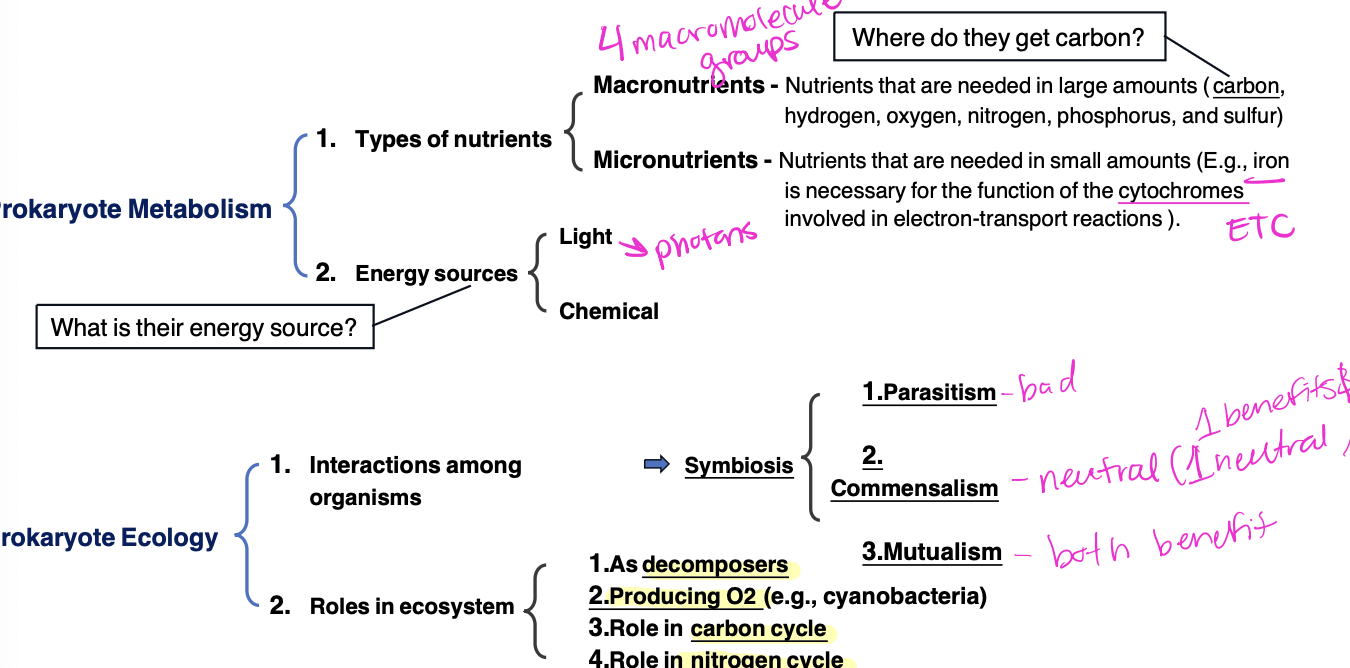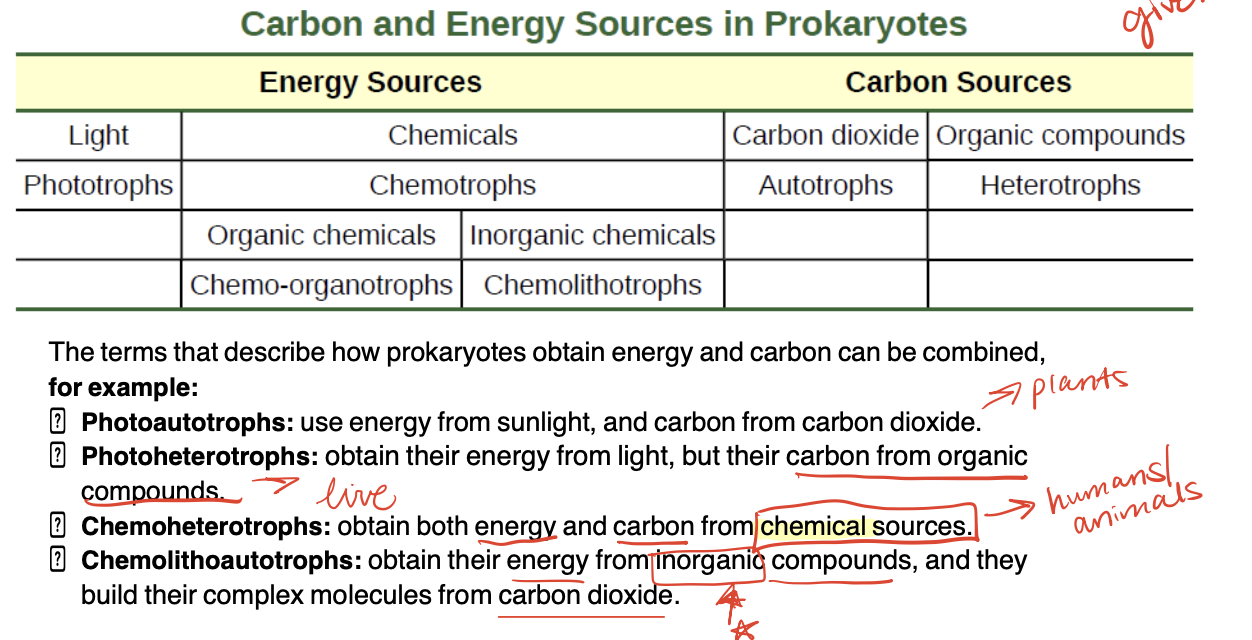Prokaryotes: Bacteria and Archaea
Chapter 22: Prokaryotes: Bacteria and Archaea
Overview:
Prokaryotes include bacteria and archaea.
They thrive in extreme conditions.
The 3 Domains of Life
Domains: Eukarya, Bacteria, Archaea.
Organisms in Eukarya include:
Land plants
Dinoflagellates
Green algae
Forams
Ciliates
Diatoms
Red algae
Cellular slime molds
Amoebas
Animals
Fungi
Archaea Examples:
Sulfolobus (thermophiles)
Halophiles
Methanobacterium
Bacteria Examples:
Spirochetes
Chlamydia
Cyanobacteria
Green sulfur bacteria
Introduction to Prokaryotes
Characteristics: Prokaryotes are single-celled organisms without a nucleus.
They reproduce asexually, primarily through binary fission.
First organisms on Earth 3.5-3. BYA
Live on and in every other living organism
most are benign (not causing 99% disease) and many are essential to all life, > 1% are pathogenic
Prokaryotic cells took a long time to be discovered because they are so small.
Leeuwenhoek had to first invent the microscope and see bacteria in 1670, which marked a significant milestone in microbiology as he was the first to observe and describe these microscopic organisms.
Historical Context of Microbiology
Koch's Postulates:
A microorganism must be found in abundance in organisms suffering from the disease but should not be present in healthy organisms.
The microorganism must be isolated from a diseased organism and grown in pure culture.
The cultured microorganism should cause disease when introduced into a healthy organism.
The microorganism must be re-isolated from the inoculated, diseased experimental host and identified as identical to the original specific causative agent.
helped establish germ theory- A: particular organisms cause a particular disease
Pure culture: a laboratory culture containing a single species of microorganism
Culture medium: contains all the nutrients needed by the target microorganism
Streptococcus Example: Demonstrates the adherence of Koch's postulates.
Gram staining: A method used to classify bacteria based on their cell wall composition, aiding in the identification and treatment of bacterial infections.
Cell structure; all cells have four common structures:
the plasma membrane functions as a barrier for the cell and separates the cell from its environment
The cytoplasm: a complex solution of organic molecules and salts inside the cell
a double-stranded DNA genome(RNA genome in virus) : the informational archive of the cell
Ribosomes(prokaryotic and eukaryotic ribosomes have the same function but different sizes): sites of protein synthesis.
Prokaryotic Structure 4
Cell walls
- lies outside the plasma membrane
protects and prevents cell lysis (rupture)
Bateria: w/ peptidoglycan (PG)
archea w/ other structural polysaccharides so not have peptidoglycan
Mycoplasmas have no cell walls
Gram positive bacteria
(thick PG layer) retain the crystal violet stain during Gram staining, appearing purple under a microscope, whereas Gram negative bacteria (thin PG layer and outer membrane) do not retain the stain and appear pink.
Gram negative bacteria
possess a more complex cell structure and are typically more resistant to antibiotics due to their outer membrane barrier.
Prokaryote Structure 5
Many have. a capsule or slime layer > glycocalyx, which provides additional protection and helps in adhering to surfaces.
Stucky carbs and proteins secreted outside cell wall: the most outer layer
Prokaryote Structure 6
Some have hair-like protein fimbriae (short pili)
helps cells stick to surfaces and each other (biofilms: resistant to anti-biotics, cleansers, and mechanical scraping)
Mant can form sex pili (transfer DNA which gives genes and genetic material)
Many have flagellum structure
Not homologous to eukaryote flagellum ( genes are completely different, or analogous)
ALLOWS MOVEMENT
Structure 8
Many prokaryotes have plasmids:
extra tiy DNA rings w/ few genes
replicate independently of the host chromosomes
not essential for life, but adds diversity (survival advantages)
Prokaryote Structure
Common Characteristics:
Often occur in aggregates: pairs, chains, clusters.
Plasmids: Extra small DNA rings that replicate independently; not essential for life but provide advantages such as drug resistance.
Differences Between Bacteria and Archaea
Differences fundamentally in:
Plasma membranes (different lipid structures)
Cell walls (Bacteria have peptidoglycan; Archaea do not)
DNA replication (different mechanisms)
Gene expression (varies significantly)
16S rRNA sequencing (ribosomal) : Provides a molecular way to differentiate these domains.
Prokaryotic Diversity
Types of Prokaryotes:
Bacteria:
Examples include:
Proteobacteria (Gram-negative, diverse metabolism)
Chlamydias (obligate endoparasites)
Spirochetes (notable morphology, distinct movement)
Cyanobacteria (photosynthetic)
Archaea:
Includes extremophiles (thermophiles and halophiles).
Non-pathogenic to humans.
keep membrane stable in high heat salts, etc.Their unique lipid composition allows them to thrive in harsh environments, playing crucial roles in nutrient cycling and biogeochemical processes.
Plasma membrane
baacterial lipids are unbranched
use ester bonds
rchaean membranes are formed on glycerol skeleton with ether linkages (not ester)
hydrocarbons may be branched or have rings
Tetraether polymer allows extremophiles to withstand high temperatures. (ex: thermophile)]


Symbiosis two species living in a close relationship (free living = not living in symbiosis)
parasitism
smaller parasite benefits at the expense of other species (host)
including pathogens ( cause disease)
ex. anthrax, cholera bacteria (human pathogen cholera)
Commensalism
One specific benefit without any impact (good or bad) on other species
ex: most bacteria on our skin (bacteria in the gut)
Mutualism
both species benefit from each other
ex: Rhizobium in legume roots get sugar and water; provide fixed N for the plant
Prokaryote Metabolic and Ecological Diversity 4
Chemoheterotrophic bacteria are the most important decomposers on earth
secreted enzymes hydrolyze dead material or wastes
absorptive: monomers ( individual amino acids, nucleic acids) enter by diffusion/active transport
metabolism releases CO2 and N, P, K, etc.
Prokaryotes in the Environment
Carbon Cycle:
Prokaryotes play a significant role in carbon cycling through processes like carbon fixation (making sugar).
important base of aquatic food webs
Nitrogen Cycle:
Key roles by prokaryotes include nitrogen fixation, nitrification, and denitrifying bacteria.
Done over fertilization
completed by other prokaryotes in soil
Prokaryote Genetic Diversity
Pathogenic Bacteria
Types of Toxins:
Exotoxins: Secreted by bacteria (e.g., Clostridium tetani).
Endotoxins: Part of the outer membrane of Gram-negative bacteria (e.g., Salmonella).
Antibiotics: Target bacterial cells without harming eukaryotic cells (e.g., penicillin affects peptidoglycan in the cell wall).
Beneficial Prokaryotes
Applications:
In DNA technology and genetic engineering.
extremophiles: bacteria and archea that are adapted to grow under extreme conditions
Used in commercial production of chemicals and enzymes.
Food production: yogurt and cheese (e.g., Lactobacillus bulgaricus).
Microbial remediation: Certain bacteria can detoxify pollutants, remove heavy metals.
Conclusion
Endospores: Under stress conditions, some bacteria can form dormant endospores, which can survive extreme conditions, e.g., Bacillus anthracis and Clostridium tetani.
Among the vast diversity of prokaryotes, significant interactions with ecosystems and human health are noted, revealing their vital roles in both pathogenic and beneficial aspects.